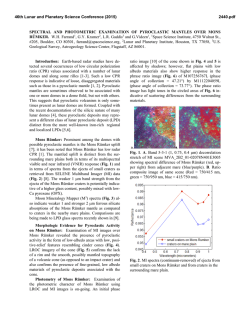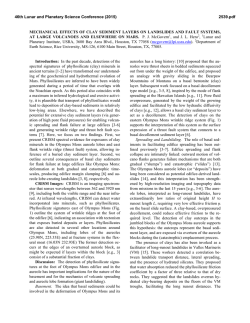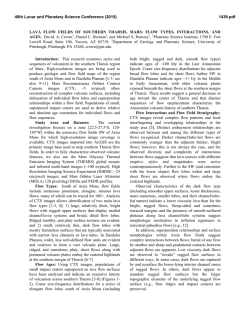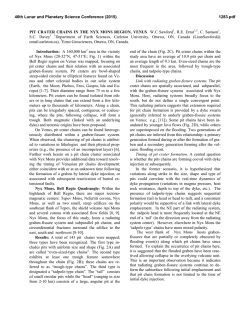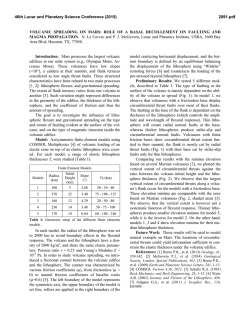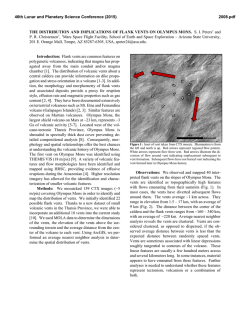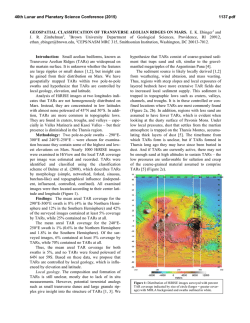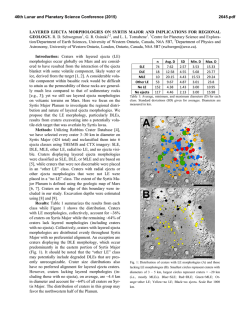
IMPROVED RESOLUTION MAPS OF HYDROGEN AT THARSIS
46th Lunar and Planetary Science Conference (2015) 2036.pdf IMPROVED RESOLUTION MAPS OF HYDROGEN AT THARSIS. J. T. Wilson1, V. R. Eke1, R. J. Massey1, R. C. Elphic2, W. C. Feldman3, S. Maurice4 and L. F. A. Teodoro5, 1Institute for Computational Cosmology, Durham University, South Road, Durham. DH1 3LE, UK ([email protected]), 2Planetary Systems Branch, NASA Ames Research Center, MS 245-3, Moffett Field, CA,94035-1000, USA, 3Planetary Science Institute, Tucson, AZ 85719, USA,4IRAP-OMP, Toulouse, France, 5BAER, NASA Ames Research Center, MS 245-3, Moffett Field, CA 94035, USA. Introduction: Evidence for late Amazonian tropical mountain glaciers on the north-western flanks of the Tharsis Montes and Olympus Mons has been detailed extensively using observations from the Mars Express, Mars Global Surveyor and Mars Odyssey orbiters [1,2,3]. The production of such glaciers is impossible given the current climatic conditions at equatorial Mars. Thus the existence of these glaciers is interpreted to be the result of the migration of volatiles (chiefly water) from the poles to the equator during past periods of high orbital obliquity. Climate models predict the accumulation of ice on the north-western slopes of these mountains, during periods of high obliquity, due to the adiabatic cooling of moist polar air [4,5]. The extent to which these equatorial deposits remain and the form in which they are present is not yet a settled question. Campbell et al. [6] see no evidence for buried ice at Pavonis Mons using the Shallow Radar (SHARAD) instrument onboard the Mars Reconnaissance Orbiter. However, morphological evidence is presented by Head et al. [7] in the form of fresh Ring-mold craters at both Pavonis and Arsia Mons, which is suggestive of the presence of buried ice today or in the very recent past. We have used the pixon image reconstruction method on data from the Mars Odyssey Neutron Spectrometer (MONS) to produce a high resolution map of the Water Equivalent Hydrogen (WEH) distribution across the surface of Mars. Elphic et al. [8] showed, also using MONS data, that despite the fact that the present climate prevents the stable presence of subsurface ice within the range accessible to the neutron data (~1m of the surface), elevated hydrogen contents are seen on the slopes of the Tharsis Montes. However the utility of this data set in constraining the distribution of water on the scale of the tropical mountain glaciers has been limited by its poor spatial resolution due to the large footprint of the MONS (its point spread function (PSF) has a full width at half maximum of ~550km). Janssen’s method was used by [9] to perform image reconstruction on the MONS data at Tharsis, however it is known that this method amplifies noise and may introduce spurious features [10]. Here we have used the pixon image reconstruction technique to improve the spatial resolution of this data set by suppressing noise and removing the effect of blurring with the PSF. At the poles this technique has been shown to give a spatial resolution of between 45-100 km [11]. Our reconstructed data set is available for the entire surface of Mars, however we will here focus on the Tharsis Montes and the implications of the WEH distribution for tropical glaciers present there. Pixon Reconstruction: The pixon method is a spatially adaptive image reconstruction process that aims to produce the simplest image consistent with the data [12,13]. Using this technique we have carried out the first global Bayesian reconstruction of a remotely sensed planetary data set, the result of which is shown in Fig. 1. The pixon method’s adaptive smoothing algorithm works such that regions of the image with a higher Fig. 1: Robinson projection showing a pixon reconstruction of the MONS prism-1 data. Underlayed is a MOLA shaded relief map. The black rectangle outlines the region shown in Fig. 2. 46th Lunar and Planetary Science Conference (2015) 2036.pdf 500km Fig. 2: Left: Gridded MONS prism-1 data at Tharsis. Right: Pixon reconstruction of the MONS prism-1 data at Tharsis, showing the WEH conversion of [15]. Underlayed is a MOLA shaded relief map. The white contours show fan shaped deposits on the slopes of the Tharis Montes (and are based on those in [16]). signal to noise ratio are given the freedom to vary on small scales and those with low signal to noise ratio vary only on larger scales. This is done to create an image that has a spatially constant information content, which has the effect of precisely maximizing the entropy of the reconstructed image. We use the prism-1 data (a measure of epithermal neutrons) from the MONS instrument of the three martian years from 2001, which has been corrected for altitude and look direction of the spacecraft and variation in environmental conditions [14]. The conversion from epithermal neutron count rate to WEH is done using the relation in Feldman et al. (2004) [15]. Results: The Tharsis region, shown with a black rectangle in Fig. 1, is presented in more detail in Fig. 2. In the reconstruction in the right panel of Fig. 2 the line of the Tharsis Montes is seen to separate regions of higher and lower WEH abundances, where the north-west side of the line is enhanced in hydrogen with abundances >7 wt% WEH on the north-west flanks of the Tharsis Montes. This hydrogen concentration is greater than that in the raw data (Fig. 2 left panel) and than in [9]. The area with the highest WEH concentration is north-west of Olympus Mons and coincides with the Lycus Sulci region where the WEH content reaches 11 wt%. Implications of the observed hydration: That we see a peak in the count rate in the reconstruction so closely coincident with the position of Olympus Mons in MOLA topography (Fig. 2) strengthens our faith in the other features shown in the reconstruction. The region of enhanced hydrogen content around Ascraeus Mons is larger than the glacial deposit identi- fied by [17]. This may be an interesting result, although establishing its significance will require determining the precise spatial resolution of the reconstruction at this location. Conclusions: We have created a high resolution map of the epithermal neutron count rate across the entire surface of Mars. Using this map we see that the WEH content on the western slopes of the Tharsis Montes is enhanced to ~7 wt%, which is higher than otherwise suggested. The enhancements are located on the north-western flanks of the Montes approximately coincident with the regions of past glaciation, predicted, by the climate models, to form during periods of high orbital obliquity. References: [1] Head J. W. and Marchant D. R. (2003) Geology, 31, 641-644. [2] Sean D. E. et al. (2005) JGR, 110, E5. [3] Sean D. E. et al. (2007) JGR, 112, E03004. [4] Forget F. et al. (2006) Science, 311, 368-371. [5] Madeleine J. -B. et al. (2009) Icarus, 203, 390-405. [6] Campbell B. A. et al. (2013) JGR, 118 436-450. [7] Head J. W. and Weiss D. K. (2014) Planet. & Space Sci., 103, 331-338. [8] Elphic, R. C. et al. LPC XXXV, Abstract #2011. [9] Elphic R. C. et al. LPC XXXVI, Abstract #1805. [10] Prettyman T. H. et al., JGR, 114, E08005 . [11] Teodoro L. F. A. et al. LPC XLIV, Abstract #2623. [12] Pina R. K. and Puetta R. C. (1993) PASP, 104, 1096-1103. [13] Eke V. R. (2001) Mon. Not. R. Astron. Soc., 324, 108-118. [14] Maurice, S. et al. (2011) JGR, 116, E11008. [15] Feldman W. C. et al (2004) JGR, 109, E09006. [16] Fastook J. L. et al. Icarus, 198, 305-317. [17] Parsons R. L. and Head J. W. LPC XXXV, Abstract #1776.
© Copyright 2025
